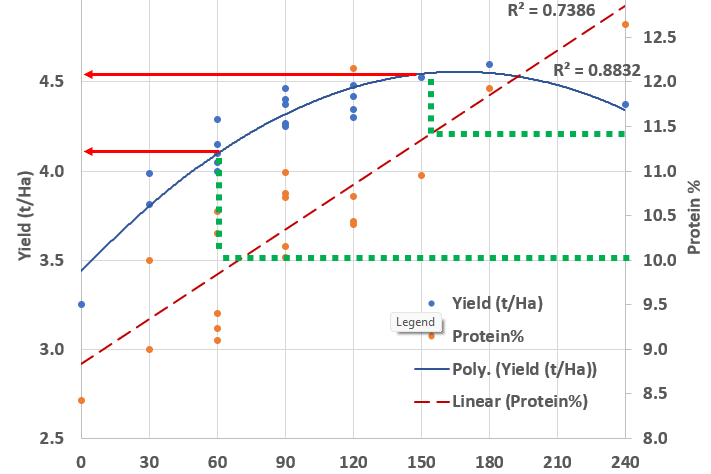Agriculture
25 June, 2024
Time to check your yield potential
AS WE move into the winter months in central Victoria with mostly well established crops and plenty of yield potential, it’s a good time to assess where we think our crops could go in relation to yield potential. Wheelhouse AGnVet agronomist...

AS WE move into the winter months in central Victoria with mostly well established crops and plenty of yield potential, it’s a good time to assess where we think our crops could go in relation to yield potential.
Wheelhouse AGnVet agronomist Andrew Bissett says nitrogen is the most important nutrient in driving yield for winter crops. To maximise moisture conversion to grain yield, crop nitrogen requirements need to be tailored to available and forecast moisture.
“October rains, Big Grains” is often spruiked, which is true, however the issue is that late season rains providing additional yield will dilute protein, which indicates that the crop has run out of nitrogen before running out of moisture. In dryland cropping systems this is a missed opportunity.
The table from a Mallee wheat trial in 2014 shows the importance of nitrogen in maximising water use efficiency. This information is also relevant to central Victoria as the same trends are always seen locally - (stored 20mm, GSR 214mm, 100mm non-productive moisture)
Water Use Efficiency
kgN/ha t/hakg grain/mm
0 2.23 17.9
20 2.7 21.7
40 2.89 23.3
60 3.22 25.9
120 3.04 24.5
The difficulty is that most of the N decisions are made and applied earlier in the season based on stored soil moisture and rainfall forecast outlook. Last year the outlook was for a drier spring and even a super El Nino, which provided little confidence in more N applications. There was however residual soil moisture from the previous very wet spring and a wet June that provided full soil moisture profiles, giving confidence to match nitrogen to average and above yield targets.
Yield is derived from the number of heads/m 2 (spikes), the number of spikelets/spike (number of grain positions on head), grains/spiklet (number of grains/position – grains wide) and grain weight. Stresses during any of these physiological growth stages can decrease yield. Nitrogen, moisture and temperature (cold or hot) stresses are the main culprits in stealing yield.
When budgeting for nitrogen requirements, water use efficiencies multiplied by stored and forecast moisture are used to predict yields. These N budgets are a moving target and adjusted throughout the growing season as moisture builds or becomes limiting. The one constant in N budgeting is protein. Grain critical protein is referenced to where yield has been maximised, and while this critical protein perecentage can vary from 10.5-12.5 per cent, typically critical protein on main season wheat will be around 11-11.5 per cent (APW1 grade). The preference is to target 11.5 per cent as this allows a buffer for a cooler wetter finish where yield will be less constrained (protein falls back) or in a drier season finish where yield is constrained but protein is pushed higher. The graph is a wheat x nitrogen trial conducted by IPF in Jamestown SA in 2017. Lee Menhenett, IPL, says
The graph illustrates the importance of nitrogen driving yield and how that is reflected in associated protein.
Yield was maximised at 150kgN/ha at around 4.5t/ha and 11.5 per cent protein (APW grade). At the lower N rate of 60kgN/ha yield dropped to around 4.1t/ha and 10 per cent protein (ASW grade).
Graph 1 looks at the wheat trial in Jamestown, South Australia, in 2017.
Grain production is directly linked to moisture, so it stands to reason that with the run of good seasons, grain yields have also been excellent.
Higher grain yields remove more nutrients from the cropping system, so it would be expected that if there is a duration of higher yielding seasons soil N reserves will fall. Lower protein wheat (ASW) is the obvious and immediate indicator that N supply has been limited. The only other method available to farmers and agronomists for N budgeting is deep soil sampling. This allows mineral N (and S) levels to be assessed and provides the N credit side of the budgeting equation. Without soil mineral N data the budgeting process becomes guess work.
Andrew Bissett, agronomist with AGnVET says early deep N tests conducted locally by AGnVET’s technical services representative Travis Jensen have shown robust urea rates in previous seasons to be holding soil N levels at reasonable levels, whereas where urea has been constrained, soil N levels are lower and this has probably been represented by low protein grain coming off those paddocks for the last four years.
Seasonal confidence in dryland winter cropping systems is primarily driven by stored soil moisture. Growing season rainfall is critical, however can be fickle, therefore confidence in any season is linked to increasing soil moisture levels. The Bureau of Meteorology rainfall accumulation totals for Victoria from December to May. The Eastern Mallee and Northern Country districts have received 200-300mm due to numerous rain events in the early summer period. With good summer weed control, at least 30 per cent of these rainfall totals should be stored in the soil. For every 1mm moisture lost through summer weed growth soil mineral N levels also reduce by 0.56kgN/ha (McMaster and Graham, 2014).
Given large grain N removal at harvest, and then excellent summer rain accumulating soil moisture, it is recommended to take deep soil samples to evaluate mineral N status, either prior to sowing or early crop development.
* Supplied by Wheelhouse AGnVet